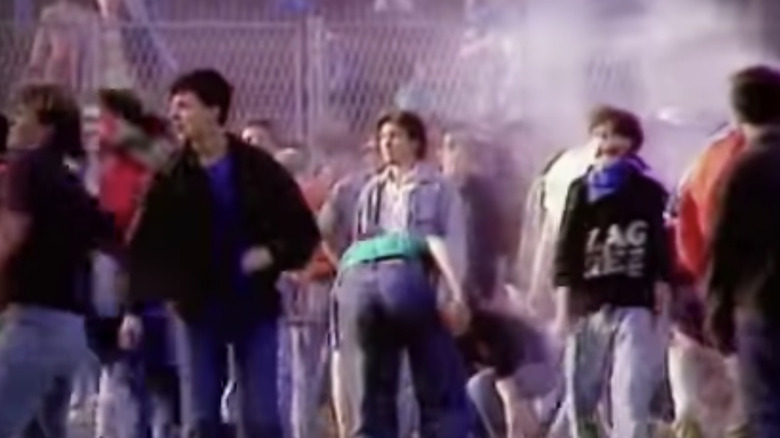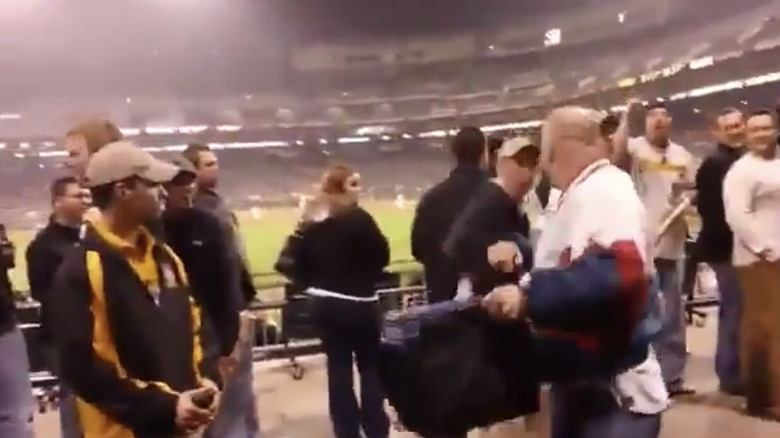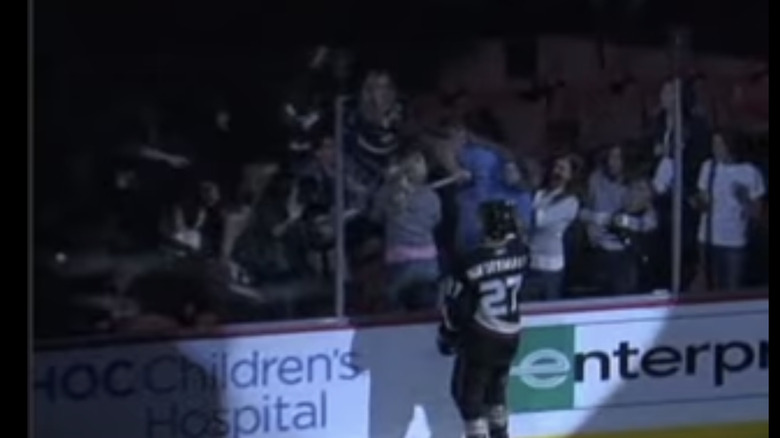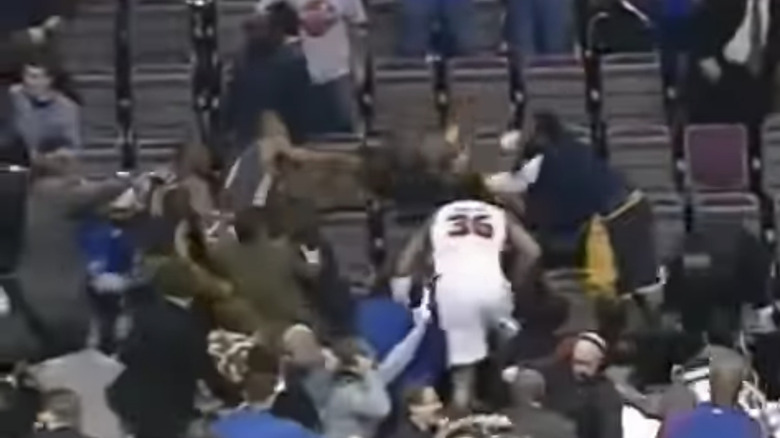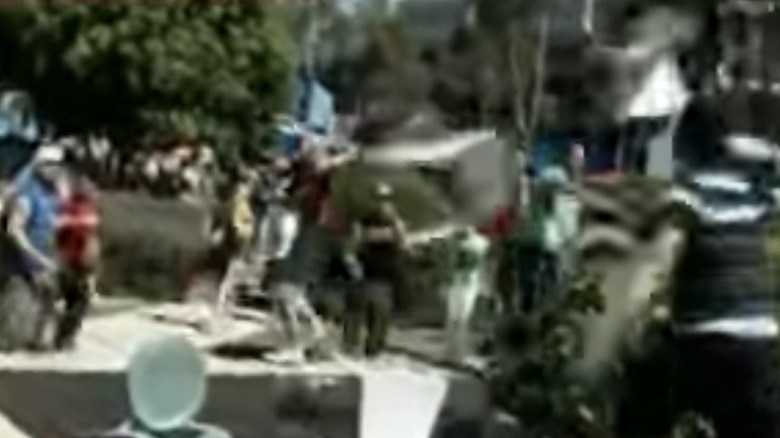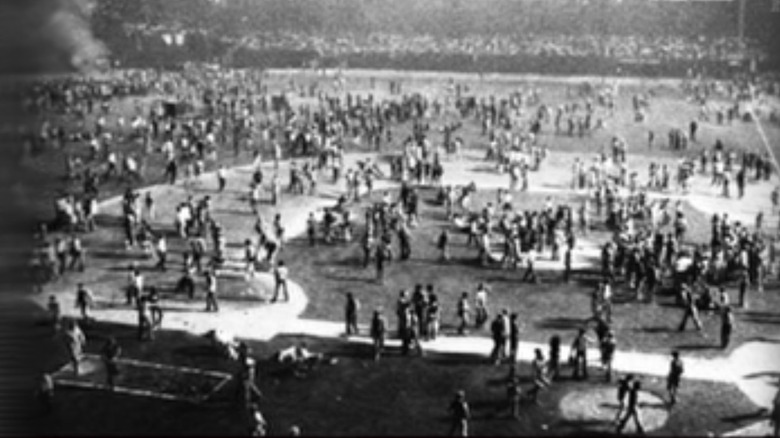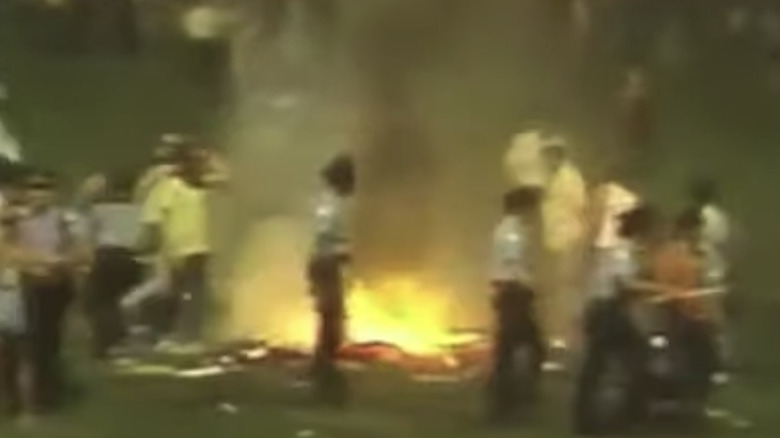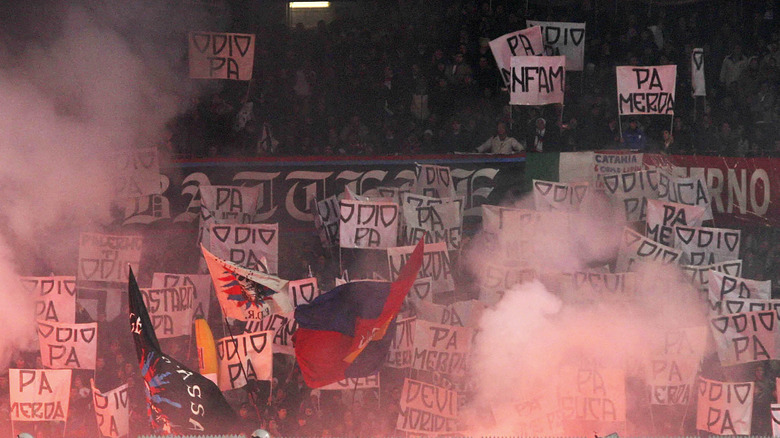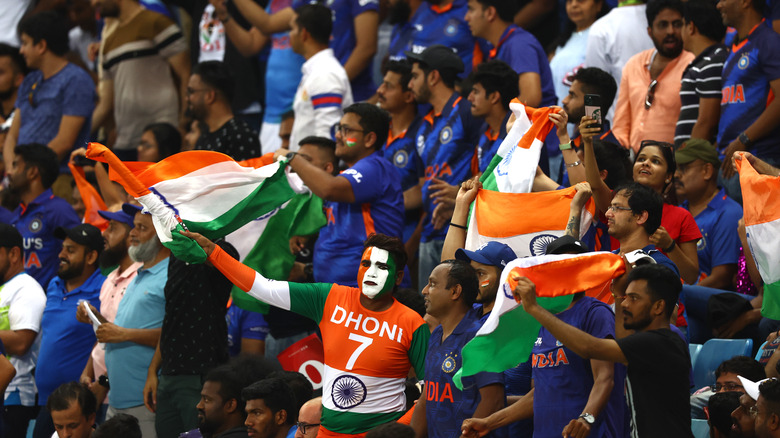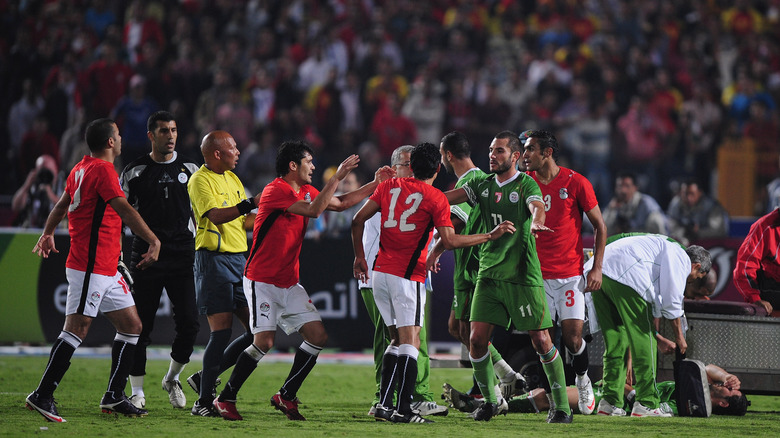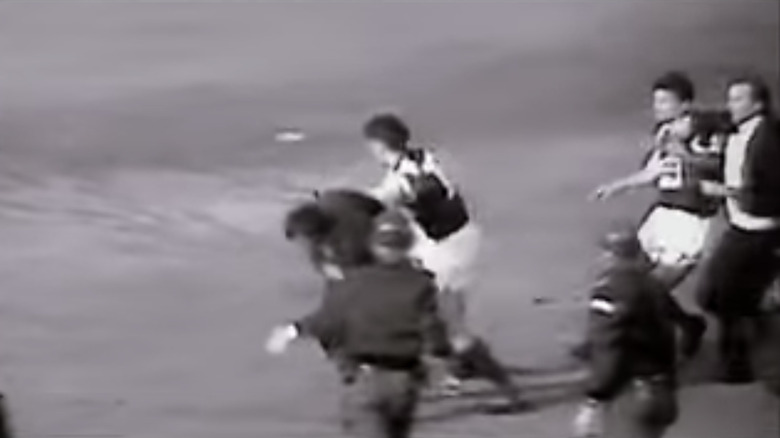The Wildest Fan Brawls In Sports History
A sports game is a place where many a fan goes to escape reality for the duration of a game and enjoy time with family or buddies over a cold beer and some hot dogs. But often, emotions and tensions between opposing fans can boil over into fights, larger brawls, or full scale riots.
So what pushes fans to participate in violence over a game? Alcohol, politics, tension, and sometimes just the adrenaline of getting involved in a massive televised fight all drive fans to violence. In America at least, most of these fights tend to be small scale, involving a few punches before security show up to eject the troublemakers (there are, of course, exceptions).
Abroad, however, the stakes of sports brawls have been much higher, particularly when sporting events are tied to national pride and ethno-religious conflicts. These tend to not result in only destructive rioting, vandalism, and arson — in one case, a fan fight eventually led to the destruction and fragmentation of an entire country. Here are some of the wildest fan fights from around the world and the impact they had both on sports and society at large.
USA! USA!
Starting the list of shame is a famous incident which took place at Pittsburgh Pirates Stadium. According to the New York Daily News, the incident unfolded with a drunk fan (fairly typical at Pirates games) named Scott Ashley, who was being unruly and looking for trouble with an usher.
In the video, stadium security was escorting Ashley out as the Pirates crowd belted "USA! USA!" in protest at the police's actions. As a fan tried to give Ashley a high-five, a "baby-faced" usher got in between the two. Ashley then nailed the usher in the face with his elbow, leading to a scuffle with police that went viral. After elbowing the usher, stadium security tased Ashley. That didn't work. Ashley, being a large, muscular individual, fought back against the police and a melee ensued as Pirates fans aided their compatriot by pelting police with trash, drinks, and spit. After several more taser attempts and use of batons, police were able to take Ashley first to the hospital and then to jail.
Per Pittsburgh's WPXI, Ashley eventually pled guilty to simple assault and resisting arrest. A judge hit him with a life ban from the Pirates' PNC Park Stadium and a restraining order preventing him from having any contact with stadium security. A bizarre incident altogether, but not completely unexpected from the Rust Belt.
All for a stick: Tampa Bay Lightning vs. Anaheim Ducks
The next brawl of shame occurred in the NHL. According to the video of the incident from the NHL, a 2009 game between the Anaheim Ducks and the Tampa Bay Lightning went to overtime. The Ducks' Canadian playmaker Scott Niedermeyer netted a winner with a soft low shot and headed over to the stands to celebrate with the fans.
At the stands, Niedermeyer tossed his stick over the barrier separating fans from the ice, starting one of the more bizarre brawls of the list. The video shows Niedermeyer seemingly giving his stick to a young blonde girl in the stands. Instead, however, a man in the front row gets it anyway. Generally, sports etiquette says that children should always get the player memorabilia over adults, and the Anaheim fans seemed to agree.
Instead of simply getting the man to give the stick to the little girl, surrounding fans began pummeling him. One woman can be seen jumping him from behind as several others throw punches at him from all sides. Niedermeyer casually skated away as if nothing had happened. In a post-game interview, he confirmed that he had intended to give the stick to the girl. The interviewer, meanwhile, urged everyone to calm down and go home. Again, not the best stadium behavior, but seemed somewhat justified. After all, what kind of person tries to one-up a child?
Malice at the Palace
While most viral brawls in America originate in the NFL and to a lesser extent the MLB, the NBA has its share of shameful moments, too. In 2004, the Indiana Pacers faced old rivals the Detroit Pistons in Michigan. According to Detroit News, the Pistons had knocked the Pacers out of the playoffs en route to the 2004 NBA title.
The Pacers were winning 97-82 when, according to the video, Indiana's Ron Artest fouled Detroit's Ben Wallace while the latter attempted a layup. Wallace shoved Artest and a player scuffle ensued. Now, this might have been limited to the court, had a fan not gotten involved. As the refs and coaches tried to separate the players, someone in the crowd threw a drink at Artest, who jumped into the stands and tackled the offending fan. Several more Pacers players and Pistons fans rushed to their compatriots' aid. The match degenerated into chaos and spilled onto the court. Pacers players were evacuated from the court for their safety as rival fans pelted them with trash and drinks.
According to ESPN, the NBA hit the responsible players with suspensions totaling over 140 games. Artest received the harshest sentence. He was suspended without pay for the whole season at the cost of $5 million. Additionally, five fans were charged for assault and banned from the Pistons Stadium, per Click on Detroit. Today, the brawl is known as "Malice at the Palace," which, despite lasting only 10 minutes, is legendary in the NBA record books as the league's most famous brawl.
The Yugoslav Wars come to the 2007 Australian Open
As noted in the Guardian, the Australian Open has a genteel reputation. Heavyweight Roger Federer referred to it as a "happy slam," while the outlet compared the atmosphere to that of a garden barbecue. The 2007 and 2009 editions of the Australian Open, however, were major exceptions to the rule, and the reason had nothing to do with tennis. Instead, the tensions originated in political tensions in — wait for it — the former Yugoslavia.
In 2007, the Australian Open brought fan violence to tennis with a brawl that saw 150 Croat and Serb fans fight each other with bottles and flagpoles. Not to be outdone, Bosnian fans decided to test their prowess against their Serb rivals two years later in 2009.
Now, according to The New York Times, the matchup between Serb superstar Novak Djokovic and American-born Bosnian Amer Delic made news not for political but also for sporting reasons. Serbia and Bosnia's brutal war in the '90s during Yugoslavia's breakup were still in memory for attendees, and tension frequently runs high when the two countries meet. Now, the match itself was hardfought, but the players showed respect for each other, with Djokovic saluting Delic after his victory in a gesture of sportsmanship. The fans, however, had other ideas. Instead of imitating the player's conduct, the fans, uninhibited thanks to copious alcohol, got into a fight outside the stadium. Fortunately, no one was killed or badly injured, although a Bosnian woman was hit with a chair. How bad was this? Not great, but not the worst sports brawl to come out of the Balkans.
The Ten-Cent Beer Night Riot
Moving on from smaller brawls to larger brawls that escalated into full-blown riots, one comes to the Indians-Rangers Riot of 1974. Like many a brawl, it was triggered by alcohol — cheap alcohol to be exact.
Clevaland today is a typical Rust Belt city well past its prime. In the 1970s, as noted in ESPN, it was in rapid decline as deindustrialization and white flight hollowed out the once-vibrant midwestern city. The Cleveland Indians were a reflection of the decay, drawing little more than 4,000 fans to games in a stadium that a decade earlier had drawn crowds 10 times that. The roster was mediocre and the team was flirting with insolvency.
In an attempt to draw its blue-collar fan base back, the Indians decided to copy the Texas Rangers, against whom they would be playing. The Rangers had held a "10-cent beer night." Unsurprisingly, the Indians fans got drunk and high while armed with pyrotechnics. The trouble began with a bare-breasted woman trying to kiss the umpire. As the game continued, Indians fans grew bolder, making forays onto the field. As the game stood 5-4 in the Rangers' favor, an Indians fan tried to steal Rangers Jeff Burroughs' cap. Rangers manager Billy Martin's response? "Let's go get 'em, boys!" In the ensuing melee, 25 Rangers players faced off against 200 Indians fans, who were armed with chains, knives, and even stadium seats wielded as clubs. Cleveland police were rushed in and dispersed the rioters after 30 minutes before things got really bad. Miraculously, no one was killed and only nine were arrested.
Disco Demolition Night Riot of 1979
A step up in the hall of shame from the '74 riot in Cleveland, the Disco Demolition Riot of 1979 occurred in Chicago under some of the most bizarre circumstances imaginable. According to Chicago's WGNTV, the riot was the brainchild of Chicago DJ Steve Dahl, who ran a promotional event as a White Sox game, inviting fans to bring disco records to destroy. This was part of the "disco sucks" movement. The deal was simple. Fans who brought a disco record to destroy would be given a discounted double-header ticket against the Detroit Tigers. The promotion worked, as over 48,000 raucous Sox fans descended on Comiskey Park with their "disco sucks" signs.
Dahl pulled his stunt after the first game of the double-header, which Detroit won 4-1. After fans burned their disco albums, many refused to return to their seats as the Sox began to warm up for game two. Eventually, 7,000 fans invaded the field and lit a massive bonfire that spread throughout the diamond and destroyed the batting cage and a considerable amount of centerfield.
With announcers and coaches unable to calm the crowd, Chicago police were called in to disperse the crowd. After 39 arrests, the Sox were forced to forfeit the series to Detroit. But all was not settled, as observers could not agree on whom to blame. Ultimately, blame fell on disco's downfall. Now, one might think that fans would want to distance themselves from such conduct. But in Chicago (perhaps unsurprisingly), however, older Sox fans still celebrate the incident as a culturally iconic event.
Catalina-Palermo Riot of 2007
So far, the brawls presented have been relatively tame, especially compared to the stuff that goes on in Europe. Among Italian soccer's fiercest rivalries, as ESPN points out, is Catania-Palermo, known as the Sicilian Derby. In 2006, it gave Italy one of its most embarrassing — and deadly — fan fights.
2006-'07 proved to be a different kind of year in Serie A, as perennial underperformers Palermo and Catania found themselves vying for spots in European club competition. 1,500 police were called in, but problems began even before the game began. The game originally was scheduled for the afternoon of February 4. But that also happened to be the feast day of St. Agatha, Catania's patron, so it was moved to the evening of February 2. The game began without incident. Law enforcement would escort Palermo's visiting fans in for their protection and everything (hopefully) would go smoothly. For whatever reason, however, Palermo's fans were not allowed into the stadium. Soon, a massive fight broke out outside the stadium and spilled onto the field. Police suspended the game and countered the rioters with tear gas to restore order.
As it turned out, Catania's Ultras (die-hard fans) had ambushed and attacked their Palermo counterparts with petrol bombs, firecrackers, pipes, and stadium seats. In the melee, a fan struck policeman Filippo Raciti in the head with a sink torn out of a stadium bathroom, killing him. The fiasco caused Italy to crack down on hooliganism and teams to review their safety measures. It remains one of Italy's worst fan incidents to date.
The Indo-Pakistani Cricket Riot of 2003
The 2003 Cricket World Cup matched political enemies and sporting rival India and Pakistan, who met in South Africa. India ran riot, cruising to a six-wicket victory over Pakistan. The win set off celebrations at home. It also stoked simmering political tensions between Hindus and Muslims inside India itself.
According to initial UPI reports, riots broke out in India's western state of Gujarat following the cricket win, noting that businesses and cars were destroyed. Per Arab News, it turned out that both sides were to blame. Hindu and Muslim crowds, which supported India and Pakistan, respectively (despite all being Indian nationals), had provoked each other to violence. Indian supporters on at least one occasion had taken their celebrations into Muslim areas (presumably politicizing the victory) and were attacked in return. In the city of Ahmedabad, Muslim youths attacked police with stones and were shot at. By the end, one was dead and several more injured.
The rioting was bad enough that it gained international attention, especially from former American president Bill Clinton. The president had referred to the bloody Gujarat Riots of 2002, which killed nearly 2,000 people, as "one of the saddest events" since his term ended in 2001. Thus, he begged in a speech broadcast across India not to repeat previous mistakes and polarize itself along religious lines.
Egypt and Algeria take things online
This one differs from the rest in that the fight's key moments took place online. African rivals Egypt and Algeria, per CNN, were competing for a place in the 2010 World Cup in South Africa. Algeria had won the first leg 2-0, so Egypt needed to win by the same scoreline in Cairo to force a tiebreaker.
Now, as noted in Gulf News, violence was expected. It had already occurred in 1989 in similar circumstances. But this time, things began online when an Algerian musician cut a music video mocking Egypt for its defeat against Israel in the 1967 Six-Day War. An Egyptian fired back mocking Algeria for being a French colony that would never have achieved independence without Egyptian help. The online war soon escalated to greater feats. According to Algerian paper El-Chorouk, Egyptian hackers took its site offline, possibly with the cooperation of the Egyptian Ministry of Information. In revenge, per the Egypt Independent, Algerian hackers hit the websites of the Egyptian President Hosni Mubarak and the newspaper Al-Ahram.
When Algeria's squad arrived in Cairo, Egyptian fans took to the streets, per Deseret News. Rioters attacked the Algerian embassy, burned Algerian flags, and would have assaulted visiting fans had the police not stopped them. They also stoned Algeria's team bus. By the end, 11 police and 24 fans were injured. But it did not end there. Egypt against all odds shocked Algeria with a goal 30 seconds from time to force a playoff in neutral Sudan. Algerians' response? Ransack Egyptian property in Algiers.
The Dinamo-Red Star Riot of 1990 (aka the riot that started a war)
Capping off the list is the most notorious riot in sports history, which started a war and triggered the death of a nation. In 1990, Yugoslavia was coming apart amid ethnic tensions, a situation reflected in its soccer league, per a documentary by TransWorld Sport. So when heavyweights Red Star Belgrade (Serbia) and Dinamo Zagreb (Croatia) met in Zagreb, violence was expected — and they got more than they bargained for.
According to the Dinamo ultras group the Bad Blue Boys (BBB), the worst of the riot started when Red Star ultras called the Delije, with the complicity of the Serb-dominated police, allegedly attacked Croatian families in the stands. The BBB responded and a massive fight broke out in the stands, with fans throwing seats, bottles, and even acid at each other. The fight spilled onto the field as police allegedly attacked the BBB but not the Delije. In response, Dinamo captain Zvonimir Boban drop-kicked an officer and became an instant national hero. The brawl, however, was just the beginning. According to Euro News, the BBB and the Delije would soon be fighting on the battlefields of the Croatian War of Independence, a conflict that yielded 20,000 dead.
Today, the fight remains legendary among Dinamo fans. As noted in the English soccer magazine When Saturday Comes, outside the Maksimir Stadium stands a memorial to the BBB and "fans of this club, who started the war with Serbia at this ground on May 13, 1990." Truly, no other brawl can come remotely close to topping this one.
